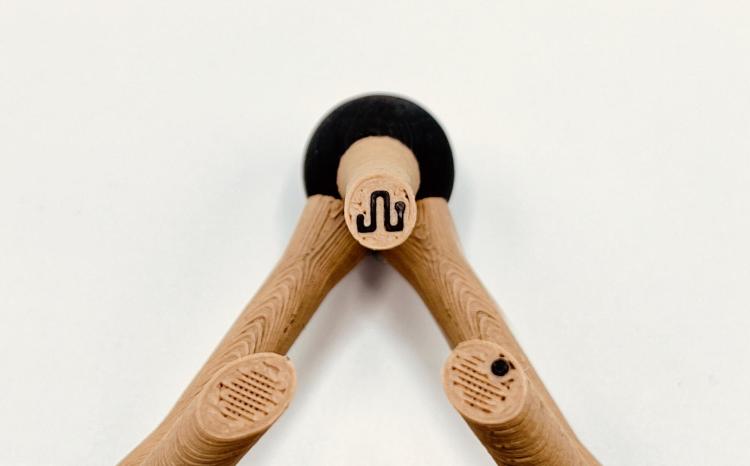ATLAS Innovators Win Big at RepRap Festival
The first annual Rocky Mountain RepRap Festival (RMRRF) took place in Loveland, CO, and the ATLAS Utility Research Lab crew showed up in a big way.
RepRap is a global movement focused on developing freely-available 3D printers that can produce most of their own components, with the goals of simplifying manufacturing, saving resources and democratizing access to fabrication tools.
The festival brought members of the regional and global 3D printing community together to celebrate innovations and intriguing experiments in replicating rapid prototyping (while enjoying a friendly Battle Racer competition or two).
In all, over 3,500 people attended, including ATLAS community members Michael Rivera, assistant professor and director of the Utility Research Lab; PhD students Sandra Bae, Eldy Lázaro, and Krithik Ranjan; and master’s student William Harris.
Most exciting of all, when it came time to announce awards, ATLAS swept three of the four categories:
- Favorite 3D Print: Will Harris, Cryogenic System Protection Flexure
- Most Innovative Project: Mike Rivera, Spent Coffee Grounds for Sustainable 3D Printing
- Most Useful/Functional Project: Sandra Bae, Multi-Material Capacitive Touch Sensor
West 3D and Community Innovation Fund sponsored the awards - check their blog for complete details.

The team reports making numerous connections among enthusiasts as well as industry and business leaders in this burgeoning space, further solidifying ATLAS and the Utility Research Lab as leading innovators in digital fabrication technology, tools and techniques.
Their highlights:
- Cocoa Press and their 3D chocolate printer
- Protopasta, a maker of a wide array of brilliantly-colored filaments
- Prusa Research printers, parts and software
- Voron Kits, which came to RMRRF with a life-size working replica of R2D2
- Rep-Raptor, a vintage 3D printer preservationist
Michael Rivera, Spent Coffee Grounds for Sustainable 3D Printing
Michael Rivera heads up the Utility Research Lab at ATLAS, with a focus on inventing and investigating digital fabrication technologies. His spent coffee grounds research came out of a frustration with the materials we currently have for 3D printing. PLA, the most commonly-used medium, is sold as “compostable,” but it is actually extremely difficult to break down. As a result, waste PLA usually ends up in landfills, where it takes up to 1,000 years to decompose.
While brainstorming alternate 3D printing materials, Rivera learned that an estimated 15 million tonnes of spent coffee grounds are generated annually, much of it going to landfills despite its rich composting properties. When chatting with the team at Arriviste Coffee in Pittsburgh, PA, he came up with the idea to test coffee grounds in 3D printing. Arriviste happily agreed to provide all the spent grounds used in Rivera’s research.
Rivera has since experimented with various types of grounds (espresso provides better printing resolution due to its finer grind) and precise ratios of grounds to readily-available food-grade binders (xanthan gum and carboxymethylcellulose) to ensure the material can be easily extruded. Most recently, he has been testing print speeds to more quickly build 3D forms.
So what does one create with a coffee grounds-based 3D printing material? Espresso cups, naturally. Rivera lined his current prints with beeswax to make them water-tight, though he plans to test carnauba wax, which may work better with hot drinks as it has a higher melting point.

Once his research is published, Rivera plans to make it all open-source. Until then, he says,
“It’s validating to be around a community passionate about the work you’re doing. It’s a breath of fresh air having gone to the festival and seen a thriving community excited about 3D printing.”
When you’re so often heads-down in academic research, it’s great to witness how your work connects with an enthusiastic audience at a gathering like the RepRap Festival.
Sandra Bae, Multi-material Capacitive Touch Sensor
Sandra Bae’s award-winning project uses computational design and multi-material 3D printing to create capacitive touch sensors within complex, non-planar objects (e.g., 3D networks). This technique can support multiple touchpoints using a single wire connection.
She said, "It was an amazing experience to talk about my research with a completely different audience than I'm used to addressing at research conferences. It was definitely worth connecting with industry members such as ProtoPasta and Prusa Research, whose products made my research possible. It was so great to see their reactions to my work! Before, I had a lot of questions about whether I was on the right track or not, but the RepRap festival was incredibly affirming. Industry, hobbyists and other academics were throwing possible application ideas left and right at me on how to further this research and provided great community feedback."

Will Harris, Favorite 3D print
Will Harris, who had a series of projects on display, said, “I had such a good time at the RepRap festival. It was my first time presenting my work in person, and I met so many people whom I admire from the community. Some of my projects got more attention than I expected, which encouraged me to publish them. I hadn't considered that earlier.” You can check out more of his work on his website.

For fellow 3D printing aficionados, the Midwest RepRap Festival will be held June 23-25 in Goshen, IN.


